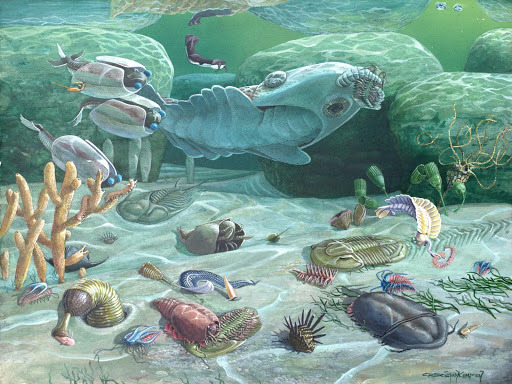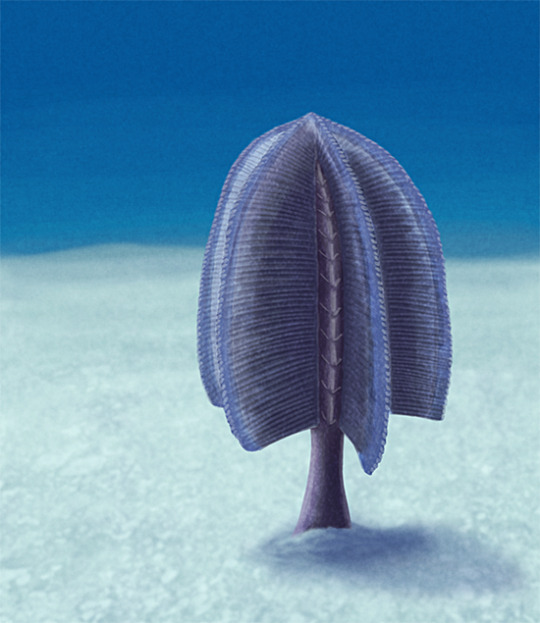#swartpuntia
Explore tagged Tumblr posts
Text

For all the long eons of the Earth, the shores have remained empty. But now, something is stirring in the depths, and after each storm that rages across the seemingly barren world, strange creatures wash up on the beach. In death, they announce to the land the first animal life in the Ediacaran sea.
I've wanted to draw the strange Ediacaran life that pre-dated even the Cambrian explosion for a while now, but had been struggling to find an interesting way to depict them. With little behaviour to show, I find Ediacaran paleoart has a bit of a tendency to end up looking like a pretty aquarium with all the organisms nicely arranged together for the viewer's enjoyment. I landed on painting them washing up on the empty shore. It's also me experimenting with watercolours instead of my usual coloured pencils.
#ediacaran#paleoart#palaeoblr#paleoblr#dickinsonia#charnia#tribrachidium#spriggina#albumares#rigonia#haootia#swartpuntia#ediacaran biota#vendobiont#my art#cw: animal death#watercolour
28 notes
·
View notes
Text
Ediacaran weirdos, AKA Pancake Pals
This week’s post is a slight digression from our ongoing series about animal diversity, because it features a group of mysterious fossils that may not even be animals!
I hope you’re in the mood for pancakes.

(Image: A reconstruction of an underwater Ediacaran environment, prominently featuring Dickinsonia and several Charnia along with other ediacaran weirdos. [Source])
In order to understand these weirdos, we’re going to have to take a trip way, way, back. Back before the dinosaurs, or before the first land animals, or before the first fish, or even before they started making sliced bread. A time called the Ediacaran period, when life was good, sediments stayed where they ought to be without nasty creatures crawling about in them, and pancakes roamed the seas looking for a meal.
Many of you are probably familiar with the Cambrian Explosion, which occurred about 530-540 million years ago in the Cambrian period and records the appearance of hard-bodied animal groups in the fossil record. This event really deserves its own post, or series of posts, but it’s important to remember that this event is not placed at the actual first appearance of these organisms, but rather their first appearance in the fossil record. It’s got to do with hard body parts being hip and trendy in the mid-Cambrian, and thus a bunch of animal groups all suddenly seeming to appear at once.
Key word, seeming. These animal groups all had to come from somewhere. Many groups appear in the fossil record around the same time in the Cambrian, fully formed, and so their ancestors must have lived previously. These ancestors just didn’t have very hard body parts, so we don’t easily find fossils of them. (There are several proposed reasons why animals all suddenly started making hard parts at the same time, but I won’t go into it here.)

(Image: A bunch of Cambrian animals, including trilobites, Wiwaxia, and early chordates. [Source])
We’re currently living in the Phanerozoic Eon, or the age of visible life. In fact pretty much every fossil organism you can think of, from Australopithecus to T. rex to trilobites to trees, has lived in the Phanerozoic. It started 542 million years ago with the Cambrian period, just before the Cambrian Explosion, and it’s marked by the first appearance of the burrows of priapulids, AKA Penis Worms. Yes, we live in the eon of the penis worm, but what’s more important is that these burrows are maybe the earliest examples of any life form actually digging into the sediment and mixing it up, a process called bioturbation.
Prior to the Cambrian, there are practically no examples of any creatures bioturbating the sediment*, which means it was pretty much fair game for microbes to go hog wild. Because nothing could get to them.
*Okay, there are some examples. But these burrows all seem to be very simple, not very deep, and pretty much just up-and-down. Not much wriggling around going on.
This formed a unique type of sediments called microbial mats or microbially-bound sediments, in which the sediments are bound together into a sort of carpet that’s resistant to being disturbed. This sets the stage for preservation of very soft-bodied creatures, and what’s more, they’re being preserved in sand rather than in much finer-grained deposits that are usually the only things that can preserve any fine details. It’s a type of preservation that’s almost unheard of in the phanerozoic.
So, with that in mind, let’s imagine ourselves in the Ediacaran! The world has just stopped being an ice planet, and you are a horrible little rangeomorph.
What’s a rangeomorph?
Good question!

Just kidding. That’s not the end of the post, but it might as well be, because the answer to “what are these ediacaran weirdos” is “we just don’t know”. They don’t really clearly resemble any living animals.

(Image: a fossil of Dickinsonia. It’s approximately oval-shaped, and looks quilted. [Source])
Like, we really don’t know. The closest we have to knowing is that some bio-geo-chemical data has indicated preservation of fossil cholesterols, which narrows it down to “they are animals, or fungi, or something that’s a close relative of animals and fungi”. They’ve been suggested to be sponges, or cnidarians (jellyfish and friends), or bilaterians, or even giant placozoans, or a TON of other things. My personal favourite idea is that they’re giant single-celled organisms similar to modern monothalameans, and that they’re not animals or fungi but rather their own little group (Many of these quilted weirdos have been grouped together in a group called petalonamae, which is sometimes called vendozoa; they’re pretttty much the same thing).
So, without further ado, here’s a little who’s-who of some of the more well-known ediacaran weirdos! I’ve already shown you Dickinsonia, the classic little pancake whom we all love. Like many of these vendozoans, it comes from Australia. The very largest get up to 1.4m long! More typically, though, they’re on the order of a few centimetres. Sometimes they’re very long, but they’re never very thick, and they have a weird “quilted” appearance.

(Image: Glide symmetry in a fossil of Charnia and in cartoon leaves.)
Although Dickinsonia appears to be symmetrical at first glance, that’s not quite true. Rather than being truly symmetrical, it has what’s called glide symmetry—i.e. the body segments are mirrored and then moved forward a little, so it’s not precisely symmetrical. This is pretty common for vendozoans.

(Image: A group of Charnia, frond-like quilted organisms that stand up, looking a bit like feathers. Image by Nobu Tamura [Source])
Another significant group of ediacaran weirdos are the rangeomorphs, of which the most famous is Charnia. It maintains the quilted appearance of Dickinsonia, but stands straight up, with a sort of anchor-point holding it to the ground. Charnia fronds are typically about 10-20cm long, but some specimens that are over 2m long have been reported.

(Image: Swartpuntia, a rangeomorph that looks like three Charnia clipped through each other badly. Image by @alphynix—go follow them if you’re not already, they do great art!)
Other rangeomorphs, like Swartpuntia, have between three and six-fold symmetry, and so look more like a lemon-juicer. It also has a name that’s very fun to say.
Swartpuntia and other rangeomorphs are pretty significant in that they represent possibly the earliest tiered ecosystems of non-microscoping life forms! While things like Dickinsonia were crawling around on the ground, rangeomorphs were taking advantage of different resources by growing tall and frondy.

(Image: A fossil of Spriggina, a flattened, elongate, vaguely phallic impression fossil. [Source])
There’s also Spriggina, which—surprise!—has been a source of debate as to what it is. It’s variously been proposed to be a worm, a trilobite relative, or a vendozoan. It has glide symmetry, though, so I’m grouping it with vendozoans here.
One thing all these vendozoans have in common, besides glide symmetry and being impressions on rocks, is that there’s very little apparent internal structure. Whether this is solely an artefact of preservation is up for debate, but there is not clearly a mouth, or gut cavity, or reproductive organs, or anything like that. It’s assumed they fed by osmosis, either by moving along the seafloor feeding on microbes in the sediment (if they were flat like Dickinsonia), or by consuming floating microbes (if they were frondy, like Charnia). It’s also assumed they reproduced asexually via fission or budding.
Whatever the vendozoans were, their time was not short lived. Between the first and last of these ediacaran weirdos, almost 70 million years passed. That’s more time than between us and T. rex! During that time they survived an ice age, but they didn’t survive the start of the Cambrian. No definite vendozoan fossils are known from the phanerozoic, and it’s pretty widely thought that the start of more intense bioturbation probably destroyed the microbial mats they relied on. So these days we have to make our own pancakes.
512 notes
·
View notes
Photo


Evidence that Earth's first mass extinction was caused by critters not catastrophe
The Earth's first mass extinction event 540 million years ago was caused not by a meteorite impact or volcanic super-eruption but by the rise of early animals that dramatically changed the prehistoric environment.
Read more of the press release.
Biotic replacement and mass extinction of the Ediacara biota
Abstract
The latest Neoproterozoic extinction of the Ediacara biota has been variously attributed to catastrophic removal by perturbations to global geochemical cycles, ‘biotic replacement’ by Cambrian-type ecosystem engineers, and a taphonomic artefact. We perform the first critical test of the ‘biotic replacement’ hypothesis using combined palaeoecological and geochemical data collected from the youngest Ediacaran strata in southern Namibia. We find that, even after accounting for a variety of potential sampling and taphonomic biases, the Ediacaran assemblage preserved at Farm Swartpunt has significantly lower genus richness than older assemblages. Geochemical and sedimentological analyses confirm an oxygenated and non-restricted palaeoenvironment for fossil-bearing sediments, thus suggesting that oxygen stress and/or hypersalinity are unlikely to be responsible for the low diversity of communities preserved at Swartpunt. These combined analyses suggest depauperate communities characterized the latest Ediacaran and provide the first quantitative support for the biotic replacement model for the end of the Ediacara biota. Although more sites (especially those recording different palaeoenvironments) are undoubtedly needed, this study provides the first quantitative palaeoecological evidence to suggest that evolutionary innovation, ecosystem engineering and biological interactions may have ultimately caused the first mass extinction of complex life.
The paper.
#ediacaran#ediacarans#precambrian#namibia#swartpuntia#extinction#science#palaeontology#paleontology#fossils#sorry i'm late with this
23 notes
·
View notes
Photo

Daily Paleo Art Month #18: Swartpuntia
We can't have a month of odd prehistoric creatures without touching on the ever-enigmatic Ediacaran biota, can we? This particular... thing... is Swartpuntia from the late Ediacaran period of Namibia and southwestern North America, about 546-542 million years ago. Up to 19cm in length (7.5in), it had somewhere between three and six leaf-shaped petaloids growing from a central stem.
Although it appears to form a taxonomic group with several other Ediacaran fossils, we still have very little clue just what any of these lifeforms were. Were they animals, algae, protists, fungi, microbial colonies? Or were they something else entirely, a strange stem group of early multicellular life that has no modern equivalent?
We just don't know.
#art#paleoart#paleontology#february daily paleo 2014#swartpuntia#erniettomorph#Ediacara#speedpaint#effing ediacarans how do they work?#we just don't know
403 notes
·
View notes